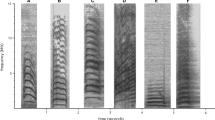Summary
Footdrumming and visual displays associated with territorial defense in the bannertail kangaroo rat (Dipodomys spectabilis) were studied in the field in Arizona. We predicted that foot-drumming functioned like bird song in territorial advertisement. Rats were tested in their territories for their responses to the presentation of four different stimuli: a playback of airborne footdrumming patterns (audio); a stuffed and mounted kangaroo rat in an aggressive posture (visual); a combination of both (audio-visual); and a playback of cricket stridulation as a control. Kangaroo rats investigated all experimental stimuli equally by becoming alert, approaching, and retreating (Fig. 2). Rats, therefore, seemed to assess the amount of threat and footdrummed at higher rates and sooner in response to the more threatening visual stumulus of a stuffed rat than to the apparently less threatening ones of a airborne footdrumming playback or cricket stridulation (Fig. 1). We conclude that rats footdrum at long ranges to repel a potential intruder and also at close ranges when territories are threatened by a persistent intruder. Chase and attack, as in territorial birds, are the final lines of defense.
Similar content being viewed by others
References
Balph DM, Balph DF (1966) Sound communication of the Uinta ground squirrels (Citellus armatus). J Mammal 47:440–450
Best TL (1972) Mound development by a pioneer [opulation of the bannertailed kangaroo rat, Dipodomys spectabilis baileyi Goldman, in eastern New Mexico. Am Midl Nat 87:201–206
Borror DJ (1965) Song variation in Maine song sparrows. Wilson Bull 77:5–37
Brown JL (1964) The evolution of diversity in avian territorial systems. Wilson Bull 76:160–169
Brown JL, Orians GH (1970) Spacing patterns in mobile animals. Ann Rev Ecol Syst 1:239–262
Davies NB (1978) Ecological questions about territorial behaviour. In: Krebs JR, Davies NB (eds) Behavioural ecology. Sinauer, Sunderland, MA, pp 317–350
Dunford C (1970) Behavioral aspects of spatial organization in the chipmunk Tamias striatus. Behaviour 36:215–231
Eisenberg JF (1963) The behavior of heteromyid rodents. Univ Calif Publ Zool 69:1–100
Elliott L (1978) Social behavior and foraging ecology of the eastern chipmunk (Tamias striatus) in the Adirondack Mountains. Smithsonian Contrib Zool 265, Smithsonian Inst Press, Washington, DC
Falls JB, McNicholl MK (1979) Neighbor-stranger discrimination by song in male blue grouse. Canadian J Zool 57:457–462
Holdenried R (1957) Natural history of the bannertail kangaroo rat in New Mexico. J Mammal 38:330–350
Jones WT (1984) Natal philpatry in bannertailed kangaroo rats. Behav Ecol Sociobiol 15:151–155
Kramer HG, Lemon RE, Morris MJ (1985) Song switching and agonistic stimulation in the Song Sparrow (Melospiza melodia): five tests. Anim Behav 33:135–149
Krebs JR (1978) Song repertoires and territory defense in the Great Tit (Parus major). Nature 271:539–542
Maynard Smith J (1982) Do animals convey information about their intentions. J Theor Biol 97:1–5
McGregor PK, Krebs JR (1984) Sound degradation as a distance cue in Great Tit (Parus major) song. Behav Ecol Sociobiol 16:49–56
Nottebohm F (1975) Vocal behavior in birds. In: Farner DS, King JR, Parkes KC (eds) Avian biology, Vol V, pp 287–326
Peek FW (1972) An experimental study of the territorial function of vocal and visual displays in the male Red-winged Blackbird (Ageliaus phoeniceus). Anim Behav 20:112–118
Randall JA (1981) Comparison of sandbathing and grooming in two species of kangaroo rats. Anim Behav 29:1213–1219
Randall JA (1984) Territorial defense and advertisement by footdrumming in bannertail kangaroo rats (Dipodomys spectabilis) at high and low population densities. Behav Ecol Sociobiol 16:11–29
Randall JA (1987) Sandbathing as a territorial scent-mark in the bannertail kangaroo rat (Dipodomys spectabilis). Anim Behav 35:426–434
Randall JA, Stevens CM (1987) Footdrumming and other antipredator responses in the bannertail kangaroo rat (Dipodomys spectabilis). Behav Ecol Sociobiol 20:187–194
Schroder GD (1979) Foraging behavior and home range utilization of the bannertail kangaroo rat (Dipodomys spectabilis). Ecology 60:657–665
Schroder GD, Geluso KN (1975) Spatial distribution of Dipodomys spectabilis mounds. J Mammal 56:363–368
Searcy WA, McArthur PD, Peters SS, Marler P (1981) Response of male song and Swamp Sparrows to neighbor, stranger, and self song. Behaviour 77:152–163
Simpson BS (1985) Effects of location in territory and distance from neighbors on the use of song repertoires by Carolina Wrens. Anim Behav 33:793–804
Smith DG (1979) Male singing ability and territory integrity in Red-winged Blackbirds (Ageliaus phoeniceus). Behaviour 68:193–206
Vorhies CT, Taylor WR (1922) Life history of the kangaroo rat Dipodomys spectabilis spectabilis Merriam. USDA Bull 1091:1–40
Waser PM, Wiley RH (1979) Mechanisms and evolution of spacing in animals. In: Marler PJ, Vandenbergh JG (eds) Social behavior and communication. Plenum Press, New York, pp 159–223
Webster DB, Webster M (1980) Morphological adaptation of the ear in the Rodent family Heteromyidae. Am Zool 20:247–254
Weeden JS, Falls JB (1959) Differential responses of male Ovenbirds to recorded songs of neighboring and more distant individuals. Auk 76:343–351
Author information
Authors and Affiliations
Rights and permissions
About this article
Cite this article
Ward, D.W., Randall, J.A. Territorial defense in the bannertail kangaroo rat (Dipodomys spectabilis): footdrumming and visual threats. Behav Ecol Sociobiol 20, 323–328 (1987). https://doi.org/10.1007/BF00300678
Received:
Accepted:
Issue Date:
DOI: https://doi.org/10.1007/BF00300678




